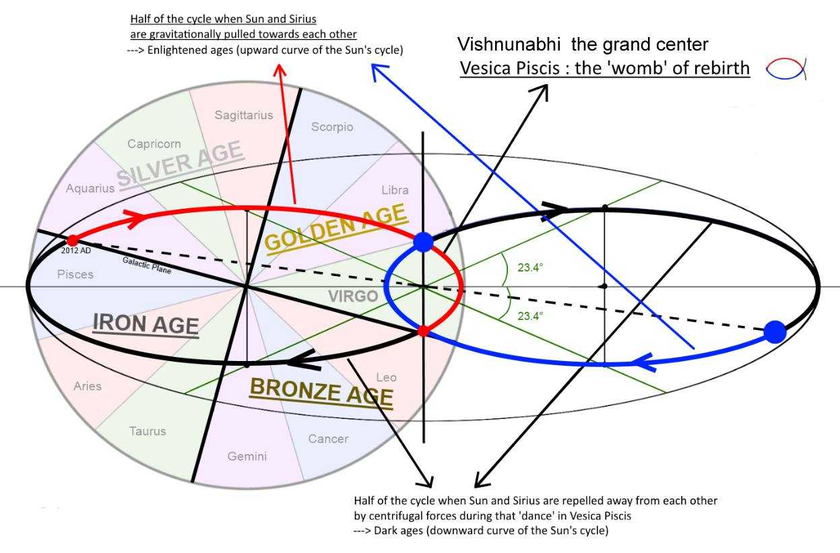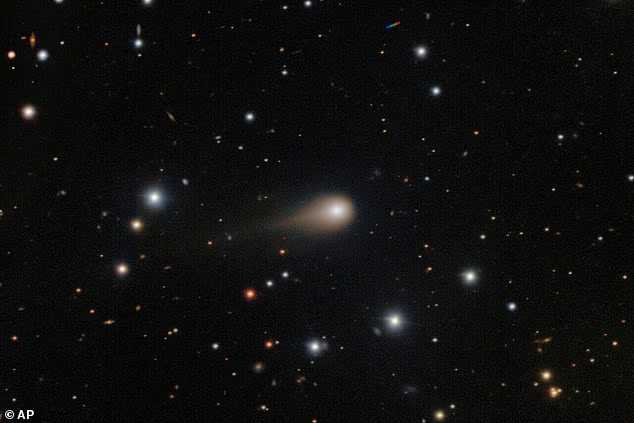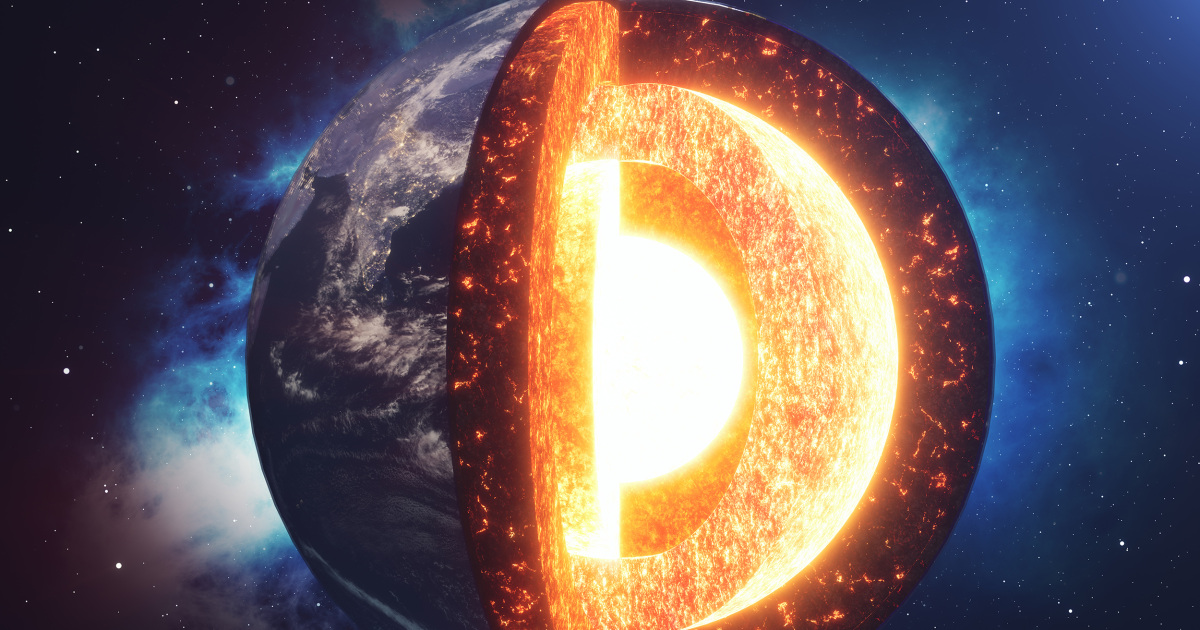Part 2 Addendum - Family Ties
The Finnish Topelius made it (The Milky Way) the starry bridge of light, Which now smiles down upon the earth from heaven's placid face, And firmly binds together still the shores of boundless space. This was built by the lovers Zulamith and Salami that they might be united in heaven as they had been on earth. They toiled and built a thousand years In love's all powerful might: And so the Milky Way was made — A starry bridge of light; and when the task was successfully accomplished they were merged together in the single star Sirius.
Allen, Richard Hinckley, 1838-1908. Star-names and their meanings
Sirius Part 3
God Star
"7. This is thy present wheel, said the Flame to the Spark. Thou art myself, my image, and my shadow. I have clothed myself in thee, and thou art my Vahan to the day, “ Be with us,” when thou shalt re-become myself and others, thyself and me. Then the builders, having donned their first clothing, descend on radiant earth and reign over men — who are themselves. . . . SD V1 pg 265
Amo_5:8 Seek him that maketh the seven stars and Orion, and turneth the shadow of death into the morning, and maketh the day dark with night: that calleth for the waters of the sea, and poureth them out upon the face of the earth: The LORD is his name:
24,000 Year Precessional Influence
The Bent Pyramid, Numbers 6 & 5, and Precession
Video >> https://www.youtube.com/watch?v=VQUYOQ0BV_I
"We learn from Oriental astronomy that moons revolve around their planets, and planets turning on their axes revolve with their moons round the sun; and the sun, with its planets and their moons, takes some star for its dual and revolves round it in about 24,000 years of our earth — a celestial phenomenon which causes the backward movement of the equinoctial points around the zodiac. The sun also has another motion by which it revolves round a grand center called Vishnunabhi, which is the seat of the creative power, Brahma, the universal magnetism. Brahma regulates dharma, the mental virtue of the internal world. When the sun in its revolution round its dual comes to the place nearest to this grand center, the seat of Brahma (an event which takes place when the Autumnal Equinox comes to the first point of Aries), dharma, the mental virtue, becomes so much developed that man can easily comprehend all, even the mysteries of Spirit.
After 12,000 years, when the sun goes to the place in its orbit which is farthest from Brahma, the grand center (an event which takes place when the Autumnal Equinox is on the first point of Libra), dharma, the mental virtue, comes to such a reduced state that man cannot grasp anything beyond the gross material creation. Again, in the same manner, when the sun in its course of revolution begins to advance toward the place nearest to the grand center, dharma, the mental virtue, begins to develop; this growth is gradually completed in another 12,000 years. Each of these periods of 12,000 years brings a complete change, both externally in the material world, and internally in the intellectual or electric world, and is called one of the Daiva Yugas or Electric Couple. Thus, in a period of 24,000 years, the sun completes the revolution around its dual and finishes one electric cycle consisting of 12,000 years in an ascending arc and 12,000 years in a descending arc.
As the Yugas are calculated from the position of the equinox, the method of numbering the years in reference to their respective Yuga is based on a scientific principle; its use will obviate much inconvenience which has arisen in the past owing to association of the various eras with persons of eminence rather than with celestial phenomena of the fixed stars.
Swami Sri Yukteswar. The Holy Science
(Hinduism) a Hindu god: in later Hindu tradition, the Creator who, with Vishnu, the Preserver, and Shiva, the Destroyer, constitutes the triad known as the Trimurti
The triad of gods consisting of Brahma the creator, Vishnu the preserver, and Shiva the destroyer as the three highest manifestations of the one ultimate reality.
The Morning Star
The Morning Star, also known as the Dog Star, is the brightest star in the heavens. It is part of a star complex that is more scientifically known as Sirius B. According to some there is a Sirius C. Therefore a Tristar ... follow along.
Isa 14:12 How art thou fallen from heaven, O Lucifer, son of the morning! how art thou cut down to the ground, which didst weaken the nations!
Lucifer (Lucent / Light) Originally Of Sound (OM)
Consciousness deteriorated when Lucifer fell and we entered Kali, The Dark or Iron Age. The further away is Sirius, the more our consciousness fell. The closer we get, the higher our consciousness will rise.
Originally Of Sound (OM)
Isa 14:12 HowH349 art thou fallenH5307 from heaven,H4480 H8064 O Lucifer,H1966 sonH1121 of the morning!H7837 how art thou cut downH1438 to the ground,H776 which didst weakenH2522 H5921 the nations!H1471
H1966
הֵילֵל
hêylêl
hay-lale'
From H1984 (in the sense of brightness); the morning star: - lucifer.
H1984
הָלַל
hâlal
haw-lal'
A primitive root; to be clear (originally of sound, but usually of color); to shine; hence to make a show; to boast; and thus to be (clamorously) foolish; to rave; causatively to celebrate; also to stultify: - (make) boast (self), celebrate, commend, (deal, make), fool (-ish, -ly), glory, give [light], be (make, feign self) mad (against), give in marriage, [sing, be worthy of] praise, rage, renowned, shine.
Rev_2:28 And I will give him the morning star.
Rev_22:16 I Jesus have sent mine angel to testify unto you these things in the churches. I am the root and the offspring of David, and the bright and morning star.
God Star - Avestan - Zoroastrianism
Sirius, the Orion belt and the Avestan Tri-star, Tištar
During maiðiiö-šam “mid-summer” celebrations, circa two weeks after summer solstice, the festival of (Juy 4) ti.štr.iiá or tristar is observed in the Avestan calendar.
Ti.štr.iiá is the brightest and most glorious of the stars in the Zoroastrian sacred lore, and is venerated as a "god being-life-force" ahü and "knower of riddles, most learned master” ratü.
The 8th Yasht (hymn, adoration) in the Avesta is devoted to tristar as a God-star and yazatá. The term yazatá denotes pure energy, animating force, vital principle and holiness. It is etymologically thesame as Greek hagios.
Also a clear link to the astral theme of the heavenly "arrow" tigra/tigri is present in the Avestan hymn, in respect to tristar or ti.štr.iiá.
According to Yasht 8th, 6-7 and 37-38, ti.štr.iiá flies in the sky as the "arrow" tigra/tigri shot by the most valiant archer of the Aryans, the hero Ereḵša
The name of the most valiant Archer of the Aryans ereḵša literally means "bear," and is a cognate of Greek árktos, Latin ursa/ursus
...
Yazatás and immortals are in essence mainiiü "sheer will and the creative power of thoughts / consciousness.” Their powers are unleashed proportional to the amount of concentration / belief in their mind energy.” Collective belief in and focus on their archetypal ideals releases their vital force and affect the world accordingly.
I shall conclude by adding that in the Avesta, Yašt 6 pays homage to the sun, Yašt 7 to the moon, Yašt 8 to ti.štriiá or Sirius, and Yašt 10 to miθra Lord of the celestial lights and friendship with the Spiritual immortals.” Also, the 13th day of each Avestan month falls under the patronage of ti.štr.iiá (Sirius) and therefore is considered as an auspicious, llucky day for Zoroastrians, since ti.štr.iiá or tistar is the protagonist of radiance, luminosity, waters / rain and blessings!
Indo Iranian tigra/tigri "arrow" associated with tri-star in the Avesta, has become the name for the first month of the summer in Persian tir"
https://www.academia.edu/26941975/Sirius_the_Orion_belt_and_the_Avestan_Tri_star_Ti%C5%A1tar
Evil Influences
Job_38:31 Canst thou bind the sweet influences of Pleiades, or loose the bands of Orion?
In early astrology and poetry there is no end to the evil influences that were attributed to Sirius. Homer wrote, in Lord Derby’s translation,
The brightest he, but sign to mortal man
Of evil augury.
Pope’s very liberal version of the same lines, —
Terrific glory ! for his burning breath
Taints the red air with fevers, plagues and death, —
seems to have been taken from the Shepheards Kalendar for July:
The rampant Lyon hunts he fast with dogge of noysome breath
Whose baleful barking brings in hast pyne, plagues and dreerye death.
Spenser, however, was equally a borrower, for we find in the Aeneid
{Page 126} The dogstar, that burning constellation, when he brings drought and diseases on sickly mortals, rises and saddens the sky with inauspicious light;
and in the 4th Georgic
Jam rapidus torrens sitientes Sirius Indos Ardebat coelo
rendered by Owen Meredith in his Paraphrase on Vergil’s Bees of Aristaeus:
Swift Sirius, scorching thirsty Ind,
Was hot in heaven.
Hesiod advised his country neighbors,
“When Sirius parches head and knees, and the body is dried up by reason of heat, then sit in the shade and drink,”
— advice universally followed, even till now, although with but little thought of Sirius. Hippocrates made much, in his Epidemics and Aphorisms, of this star’s power over the weather, and the consequent physical effect upon mankind, some of his theories being current in Italy even during the last century; while the result of all physic depended upon the sign of the zodiac in which the sun chanced to be.
Manilius wrote of Sirius:
From his nature flow
The most afflicting powers that rule below.
The astrological influences of the constellation Canis Major
Legend: This constellation is said to represent the dog set by Jupiter to guard Europa whom he had stolen and conveyed to Crete. According to other accounts, however, it was either Laelaps, the hound of Actaeon; that of Diana’s nymph Procris; that given by Aurora to Cephalus; or finally one of the dogs of Orion. [Robson, p.34.]
Influences: Ptolemy states that the stars of this constellation, with the exception of Sirius, are like Venus. It is said to give good qualities, charity and a faithful heart, but violent and dangerous passions. There is some danger from, or fear of, darkness and the night, and liability to dog bites, though the latter characteristic is probably associated more particularly with Sirius. Canis Major is connected by the Kabalists with the Hebrew letter Tzaddi and the 18th Tarot Trump, “The Moon”. [Robson, p.34.]
“It is Orion who leads the constellations as they speed over the full circuit of the heavens. At his heels follows the Dog outstretched in full career: no star comes on mankind more violently or causes more trouble when it departs. Now it rises shivering with cold, now it leaves a radiant world open to the heat of the Sun [translator’s note: In ancient times the Dogstar’s evening rising occurred in early January, its evening setting in early May (for an explanation of these terms see the Loeb Aratus, Introduction E, or Dicks 12]: thus it moves the world to either extreme and brings opposite effects. Those who from Mount Taurus’ lofty peak observe it ascending when it returns at its first rising learn of the various outcomes of harvests and seasons, what state of health lies in store, and what measure of harmony. It stirs up war and restores peace, and returning in different guise affects the world with the glance it gives it and governs with its mien. Sure proof that the star has this power are its colour and the quivering of the fire that sparkles in its face. Hardly is it inferior to the Sun, save that its abode is far away and the beams it launches from its sea-blue face are cold. In splendour it surpasses all other constellations, and no brighter star is bathed in ocean or returns to heaven from the waves. [Manilius, Astronomica, 1st century AD, book 1, p.34-37]
“The brilliant constellation of the Dog: it barks forth flame, raves with its fire, and doubles the burning heat of the Sun. When it put its torch to the earth and discharges its rays, the earth foresees its conflagration and tastes its ultimate fate [translator’s note: the ecpyrosis of the Stoics, who held that the Universe would ultimately be engulfed in conflagration and all things would return to the condition of primeval fire]. Neptune lies motionless in the midst of his waters and the green blood is drained from leaves and grass. All living things seek alien climes and the world looks for another world to repair to; beset by temperatures too great to bear, nature is afflicted with a sickness of its own making, alive, but on a funeral-pyre: such is the heat diffused among the constellations, and everything is brought to a halt by a single star. When the Dogstar rises over the rim of the sea, which at its birth not even the flood of Ocean can quench, it will fashion unbridled spirits and impetuous hearts; it will bestow on its sons billows of anger, and draw upon them the hatred and fear of the whole populace.
“Words run ahead of the speakers: the mind is too fast for the mouth [translator’s note: the impetuosity of the speaker causes him to utter words before he has time to adapt them to grammar or logic]. Their hearts start throbbing at the slightest cause, and when speech comes their tongues rave and bark, and constant gnashing imparts the sound of teeth to their utterance. Their failings are intensified by wine, for Bacchus [meaning alcohol] gives them strength and fans their savage wrath to flame.
“No fear have they of woods or mountains, or monstrous lions, the tusks of the foaming boar, or the weapons which nature has given wild beasts; they vent their burning fury upon all legitimate prey.
“Lest you wonder at these tendencies under such a constellation, you see how even the constellation itself hunts among the stars, for in its course it seeks to catch the Hare (Lepus) in front.” [Manilius, Astronomica, 1st century AD, book 5, p.316-319].
https://www.youtube.com/watch?v=bUTQTVtezhk
They are three, synthesized by the fourth (the first and highest), which is called the “ Central Sun ” in the Kabalistic doctrine just quoted.
Thus, though the seventh principle reaches man through all the phases of being, pure
as an indiscrete element and an impersonal unity, it passes through (the Kabala teaches from) the Central Spiritual Sun and Group the second (the polar Sun), which two radiate on man his Atma.
Group Three (the equatorial Sun) (Sirius???) cement the Buddhi to Atman and the higher attributes of Manas, while group Four (the spirit of our visible sun) endows him with his Manas and its vehicle — the Kama rupa, or body of passions and desires, the two elements of Ahamkara which evolve individualized consciousness — the personal ego. " SD V2 pg 241
Cyclical Events / Holy Roller / Horses / Balls / Trains / Nameless Messenger (3i/Atlas)
Black Cloud
"Arthur C. Clarke, a more consistent writer of good science fiction than Hoyle, although he only equaled Hoyle at his best, stated as his ‘Third Law’ that ‘any sufficiently advanced technology is indistinguishable from magic.’ The Black Cloud reinforces the message in spades. Pizarro fired his cannon, and was taken for a god by the Incas. Imagine if he had arrived in a helicopter gunship instead of on a horse. Imagine the response of a medieval peasant, or even aristocrat, to a telephone, a television, a laptop computer, a jumbo jet. The Black Cloud vividly conveys to us what it would be like to be visited by an extraterrestrial being whose intelligence would seem god-like from our lowly point of view. Indeed, Hoyle’s imagination far outperforms all religions known to me. Would such a super-intelligence then actually be a god?"
Richard Dawkins from Hoyle, Fred. The Black Cloud (p. 214).
Mystery Heavenly Body Discovered, a front page story
31-Dec-1983...
The brain is of strands and it is duplicated by your hair which is an extension of your brain and captures prana, the electricity of the air! The brain is an electromagnetic device which receives energy (emf) and transmits it into thoughts, images, smells, sounds etc. of the 5 senses. The hair captures prana and feeds the brain, which is why the hair comes out of your head. It is foolishness, to cut, dye or do anything that damages the hair on any part of your body, especially the head! IMO Cutting and dying hair is egotism (or cultural slavery) and is one of the greatest impediments to achieving higher consciousness through the collection of prana or Light!
Re-Discoveries of Science - Living on an Onion Planet
Deep inside Earth, scientists find weird blobs and mountains taller than Mount Everest
"Researchers such as Barbara Romanowicz at the University of California, Berkeley are using seismic (earthquake) waves to scan our planet’s innards, much like doctors use ultrasound to peer inside patients. What they’re seeing is full of complex detail — not a bland mineral hunk, but a rich and dynamic inner landscape.
The mantle appears to be layered like an onion, with major transitions 250 miles and 410 miles down. At the 410-mile level, researchers recently identified a tremendous interior mountain range, with peaks perhaps even taller than Mount Everest. “Recently, we’ve discovered another change at about 1,000 kilometers [600 miles] depth,” Romanowicz says."
https://www.nbcnews.com/mach/science/deep-inside-earth-scientists-find-weird-blobs-mountains-taller-mount-ncna997111





























